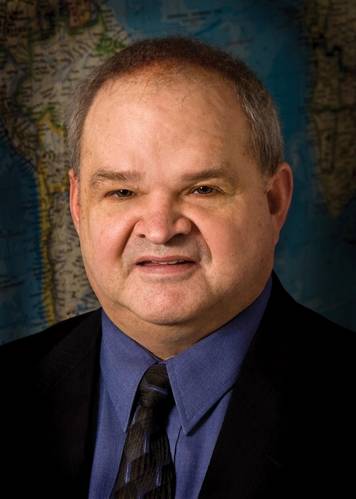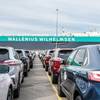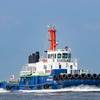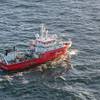Oceanex Is Building Innovation
Into Largest Canadian Flag Con/Ro Ship
Seated at his desk with a view of St. John’s harbour, Oceanex Executive Chairman Captain Sid Hynes is highlighting the innovation in the Oceanex Connaigra, Oceanex Inc.,’s 210-m custom-designed container/roll on roll off (Con/Ro) ice class 1A ship that is presently coming to life in the Flensburger Schiffbau-Gesellschaft mbH & Co. (FSG) shipyard in Flensburg, Germany. According to FSG, it will be “one of the longest, most innovative, environmentally friendly, and flexible Con/Ro ferries in the world.”
Following four years of study and research, the design stage was completed. First steel was cut in October 2012, and the keel was laid on February 11, 2013. The Oceanex Connaigra will become the largest Canadian flag Con/Ro ship with its carrying capacity of 19,500 deadweight tonnes and service speed of 20 knots. It is expected to go through first-year ice in the Gulf of St. Lawrence at close to full speed. Based in St. John’s, Newfoundland, Oceanex provides intermodal transportation services throughout eastern Canada and carries approximately half of all freight to Newfoundland. The fleet currently consists of Oceanex Avalon (1,004 TEU LoLo), Oceanex Sanderling (1,125 TEU RoRo), and Cabot (644 TEU RoRo). The Oceanex Sanderling and the Cabot can transport trailer traffic and automobiles utilizing their RoRo decks.
To address the MARPOL Annex VI emissions regulation that will be going into effect in 2015 and to ensure the Oceanex Connaigra will be environmentally friendly, a dry scrubber air emission cleaning system designed by Couple (Germany) will be installed. The decision was made after viewing a prototype dry system in Germany. According to FSG, this is the first shipboard dry exhaust gas cleaning system in the world. The Oceanex team decided to go this route after researching all available systems including wet scrubber systems. “We couldn’t find a system that had been in operation for a year where everybody was singing its praises,” said Capt. Hynes. The dry scrubber system uses pelletized hydrated lime which reacts with the sulfur, causing the sulfur to attach to the lime resulting in close to zero sulfur emissions. This technology has been applied in shore-based power stations, said Thomas Ritte, FSG’s Vice President, Sales. Because the lime is heated to such a high temperature, the oily residues and soot that are normally present in exhaust gases are burned off in the scrubber. The lime will be carried in specially designed container tanks to the ship where it will be loaded into onboard silos. From the silos, the lime is transferred to mix the exhaust gases utilizing a pneumatic control system. The amount of lime used is dependent on the fuel sulfur content. The spent lime can be used as fertilizer or in the manufacture of gypsum board. Capt. Hynes reports that DNV has classified the Oceanex Connaigra as a “clean ship”. What makes the dry scrubber system technically and economically most advantageous, said Ritte, is the power that is required mainly runs small conveyor belts and a blower, compared to pumps required by wet systems which impact the electrical balance and demand larger generators.
He adds that there are no pollutants left behind—only gypsum—compared to the sulfur-water mixture that has to then be pumped ashore. He sees this system as attractive for new builds, particularly those that will operate short-sea shipping, as the space requirement for the storage of granulate would reduce payload capacity on long voyages. To compete directly with the 53-ft. tractor trailers used in road traffic, the ship will carry all types of containers, including 20-, 40-, 48- and 53-ft. and open tops and flat decks which are 13 ft. longer, wider and 9.5 ft. high. The open top accommodates varying cargo configurations and enables efficiencies when handling unusual-shaped loads, such as pallets of lumber. The 9’ 6” high containers will be stacked four to six high on the Oceanex Connaigra. However, these specially designed units can be stacked up to 11 high as is currently being done on the Oceanex Avalon. The Oceanex Connaigra is designed such that, with respect to weather deck strength and stability, the vessel can carry up to 11,000 metric tonnes. “There won’t be navigational visibility issues,” said Capt. Hynes, “because the accommodations are forward,” adding that container ships typically carry 5,500 tons, and the average RoRo carries 2,000 to 3,000 tons. Whereas containers on conventional ships must be lashed on all voyages, due to the ship’s active and passive stabilization systems, lashing will be reduced and will only be required during periods of extreme weather conditions. The Oceanex Connaigra is fitted with three flume tanks which are located above the weather deck aft. During periods of rough seas and high winds they will work in combination with two gyro-controlled fins to reduce ship motions. The fins are retractable, wide and extend out 20 ft. when operational. “We hope to have the most stable platform that is reasonably possible, which will enable us to reduce lashing costs over the life of the ship,” Capt. Hynes said. “It costs a lot of money and ship time to lash and unlash every trip. We see having stabilizers and flume tanks as a way to reduce the lifecycle costs on the ship.” FSG’s Ritte said this is the first instance of both flume tanks and stabilizers he has seen on a Con-Ro ship.
To maximize maneuverability in port in high winds and to avoid the use—and expense—of tugs, the Oceanex team specified 8,000 horsepower spread over four thrusters to provide mechanical redundancy and reliability. “We want to be able to maneuver the ship in 30 to 35 knot winds,” said Capt. Hynes who is also thinking of the confined space at the Bickerdike Terminal where Oceanex ships dock in Montreal. “We want to ensure we have control over the situation at all times.” He credits FSG for their excellent detailed engineering work, assistance with the maneuverability studies regarding hydrostatics and stability modeling, and various other analyzes.
To further promote reliability, the Oceanex team specified two engines and one propeller on a single screw. “If you have a twin-screw ship and you lose an engine in a serious event, you’re out of service for an extended period of time,” said Capt. Hynes. He figures if one engine goes, the ship can continue on the other engine at a service speed of up to 16 knots.
There are speed limits in the St. Lawrence River, he says, adding that with a single screw, they can meet these speed limits on one engine thus saving wear and tear without giving up any rudder control. With a twin-screw ship, one engine down would cause the loss of significant maneuverability in the stern and tug support would be required during dockings. In addition, the open water speed would likely be close to 10 to 11 knots. Reliability is paramount at Oceanex which boasts on-time performance at greater than 99%.
Stern and side ramps accommodate the RoRo traffic onboard shore gantry cranes in Montreal and Halifax, whereas the Liebherr cranes in St. John’s are utilized to handle container traffic. An overhead clearance of 7.5 m inside the 12-m-wide stern door allows for the transportation of heavy loads (for example, a 300-ton load of transformers). Hoistable car decks allow for quick conversion to either automobiles or tractor trailers for optimal carrying capacity, and there is room beneath the main deck for either three car decks or one car deck and one trailer deck. The design provides for a wide variety of different cargoes—containers, cars, trucks, trailers, and project cargo, says Ritte, who adds, “Its flexibility is quite unique.”
As for the cost—in excess of $100 million—Capt. Hynes says, “We’re not looking for a cheap ship. We want the right ship. We choose to pay now in hopes we don’t have to pay later. Over the long haul, we will save money.” Designed to support the company’s growth over the next 35 years, delivery of the Oceanex Connaigra is scheduled for October.
Captain Sid Hynes
In recognition of Captain Sid Hynes’ longstanding contribution to the development of the offshore industry in Newfoundland and Labrador, Noia (Newfoundland Oil and Gas Industries Association) presented him with its Outstanding Contribution Award in February 2012. In the same month, Oceanex was named one of Canada’s 50 Best Managed Companies by Deloitte, CIBC, National Post, and Queen’s School of Business. Capt. Hynes began his 35+ year career in the marine industry by serving as an assistant steward and, over time, by serving in senior levels onboard offshore vessels supporting early drilling operations off the coast of Labrador. He became the first Canadian Diving Support Vessel Master, served as a captain in the offshore industry for all the major oil companies, and founded Canship Limited in 1986. After a joint venture was formed with the JJ Ugland Group of Norway, he became Chairman of Canship Ugland Limited which was founded to operate three shuttle tankers on the Grand Banks and currently operates the largest Canadian-based vessels carrying deadweight tonnage. He negotiated the only known 25-year-term labor union agreement, which covers the Hibernia shuttle tanker operations, which is currently in its eighteenth year.
In 2000, the Government of Canada appointed Capt. Hynes to manage Marine Atlantic, the largest Crown corporation in Atlantic Canada. In 2007, he led a consortium that acquired Oceanex and, in 2009, directed the formation of Oceanex Offshore which formed a joint venture with Stena Drilling PTE Limited of Aberdeen, resulting in the formation of Stena Drilling (Canada) Corp. This company provides Canadian operations personnel in support of Stena Drilling’s worldwide operations.
Capt. Hynes serves as Chair of the Industry Advisory Committee of Memorial University’s Fisheries and Marine Institute and is a member of the Canadian Coast Guard Marine Advisory Committee.
(As published in the March 2013 edition of Maritime Reporter & Engineering News - www.marinelink.com)

















